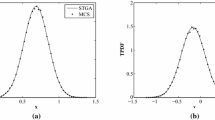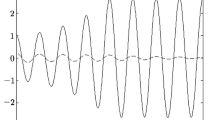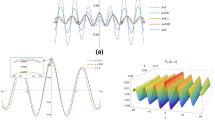Abstract
A stochastic differential equation model is considered for nonlinear oscillators under excitations of combined Gaussian and Poisson white noise. Since the solutions of stochastic differential equations can be interpreted in terms of several types of stochastic integrals, it is sometimes confusing about which integral is actually appropriate. In order for the energy conservation law to hold under combined Gaussian and Poisson white noise excitations, an appropriate stochastic integral is introduced in this paper. This stochastic integral reduces to the Di Paola–Falsone integral when the multiplicative noise intensity is infinitely differentiable with respect to the state. The stochastic integral introduced in this paper is applicable in more general situations. Numerical examples are presented to illustrate the theoretical conclusion.








Similar content being viewed by others
Abbreviations
- t :
-
Time
- m :
-
Mass
- k :
-
Stiffness coefficient
- x(t):
-
Displacement depending on time
- \(\dot{x}(t)\) :
-
First derivative of x(t) with respect to time t
- \(\overset{..}{ x}(t)\) :
-
Second derivative of x(t) with respect to time t
- \(g(x(t), \dot{x}(t)\) :
-
A function of x(t) and \(\dot{x}(t)\) which appears as a generalized force term
- \(f(x(t), \dot{x}(t))\) :
-
A function of x(t) and \(\dot{x}(t)\) which appears as the coefficient of noise term
- B(t):
-
Brownian motion
- \(\dot{B}(t)\) :
-
Gaussian white noise defined as the generalized time derivative of the Brownian motion B(t)
- C(t):
-
Compound Poisson process
- \(\dot{C}(t)\) :
-
Compound Poisson white noise defined as the generalized time derivative of the compound Poisson process C(t)
- N(t):
-
Poisson process
- \(\tilde{\lambda }\) :
-
Intensity parameter of the Poisson process N(t)
- b :
-
A constant representing the weight of B(t) in L(t)
- c :
-
A constant representing the weight of C(t) in L(t)
- \(U(t-t_i)\) :
-
A unit step function at time \(t_i\)
- \(\delta (t-t_i)\) :
-
Delta function at time \(t_i\)
- \(R_i\) :
-
Random variable representing the ith impulse in C(t)
- L(t):
-
A stochastic process defined as \( bB(t)+cC(t)\)
- \(\dot{L}(t)\) :
-
Combined Gaussian and Poisson white noise defined as the generalized time derivative of the stochastic process L(t)
- \(\mathbf {y} (t)\) :
-
State variable defined as \(\begin{pmatrix}x(t)\\ \dot{x}(t) \end{pmatrix}\)
- A :
-
A matrix defined as \(\begin{pmatrix} 0 &{}\quad 1\\ -\dfrac{k}{m} &{}\quad 0\end{pmatrix}\)
- \(\omega \) :
-
A variable defined as \(\sqrt{\dfrac{k}{m}}\)
- \(\star \) :
-
Ito calculus
- \(\circ \) :
-
Stratonovich calculus
- \(C(s-)\) :
-
The left limit of C(s) at s
- \(\Delta C(s)\) :
-
The jump size of C(s) at s, defined as \(C(s) - C(s-)\)
- \(\underline{\dot{x}} (t_i, r)\) :
-
The value of \(\dot{x}(s)\) at \(s=t_i\) as C(s) jumped from \(C(t_i-)\) to r
References
Oksendal, B.K.: Stochastic Differential Equations: An Introduction with Applications, 6th edn. Springer, Berlin (2003)
Klebaner, F.C.: Introduction to Stochastic Calculus with Applications, 2nd edn. Imperial College Press, London (2005)
Zhu, H.T.: Multiple-peak probability density function of non-linear oscillators under gaussian white noise. Probab. Eng. Mech. 31, 46–51 (2014)
Zhao, Z.H., Chang, K., Neito, J.J.: Asymptotic behavior of solutions to abstract stochastic fractional partial integrodifferential equations. Abstr. Appl. Anal. 2013, 138086 (2013)
Luo, G., Liang, J., Zhu, C.: The transversal homoclinic solutions and chaos for stochastic ordinary differential equations. J. Math. Anal. Appl. 412, 301–325 (2014)
Wong, E., Zakai, M.: On the relation between ordinary and stochastic differential equations. Int. J. Eng. Sci. 3, 213–229 (1965)
Ibrahim, R.A.: Parametric Random Vibration. Research Studies Press, Champaign (1985)
Yong, Y., Lin, Y.K.: Exact stationary response solution for second order nonlinear systems under parametric and external white noise excitations. J. Appl. Mech. Trans. Am. Soc. Mech. Eng. 54, 414–418 (1987)
Shi, J., Chen, T., Yuan, R., Ao, P.: Relation of a new interpretation of stochastic differential equations to ito process. J. Stat. Phys. 148, 579–590 (2012)
Yuan, R., Ao, P.: Beyond ito versus stratonovich. J. Stat. Mech. P07010 (2012). doi:10.1088/1742-5468/2012/07/P07010
Volpe, M., Helden, L., Brettschneider, T., Wehr, J., Bechinger, C.: Influence of noise on force measurement. Phys. Rev. Lett. 104, 170602 (2010)
Di Paola, M., Falsone, G.: Ito and stratonovich integrals for delta-correlated processes. Probab. Eng. Mech. 8, 197–208 (1993)
Di Paola, M., Falsone, G.: Stochastic dynamics of non-linear systems driven by non-normal delta-correlated processes. ASME J. Appl. Mech. 60, 141–148 (1993)
Caddemi, S., Di Paola, M.: Ideal and physical white noise in stochastic analysis. Int. J. Non-linear Mech. 31(5), 581–590 (1996)
Proppe, C.: The wong-zakai theorem for dynamical systems with parametric poisson white noise excitation. Int. J. Eng. Sci. 40, 1165–1178 (2003)
Di Paola, M., Pirrotta, A.: Direct derivation of corrective terms in sde through nonlinear transformation on fokker-planck equation. Nonlinear Dyn. 36, 349–360 (2004)
Pirrotta, A.: Non-linear systems under parametric white noise input: digital simulation and response. Int. J. Non-linear Mech. 40, 1088–1101 (2005)
Pirrotta, A.: Multiplicative cases from additive cases: Extension of Kolmogorov–Feller equation to parametric poisson white noise processes. Probab. Eng. Mech. 22, 127–135 (2007)
Zeng, Y., Zhu, W.Q.: Stochastic averaging of quasi-linear systems driven by poisson white noise. Probab. Eng. Mech. 25, 99–107 (2010)
Zeng, Y., Zhu, W.Q.: Stochastic averaging of n-dimensional non-linear dynamical systems subject to non-gaussian wide-band random excitations. Int. J. Non-linear Mech. 45, 572–586 (2010)
Wan, J., Zhu, W.: Stochastic averaging of quasi-integrable and non-resonant hamiltonian systems under combined gaussian and poisson white noise excitations. Nonlinear Dyn. 76, 1271–1289 (2014)
Liu, W., Zhu, W., Jia, W.: Stochastic stability of quasi-integrable and non-resonant hamiltonian systems under parametric excitations of combined gaussian and poisson white noises. Int. J. Non-linear Mech. 58, 191–198 (2014)
Grigoriu, M.: The ito and stratonovich integrals for stochastic differential equations with poisson white noise. Probab. Eng. Mech. 13, 175–182 (1998)
Hu, S.L.J.: Closure on discussion by di paola, m. and falsone, g., on “response of dynamic systems excited by non-gaussian pulse processes”. ASCE J. Eng. Mech. 120, 2472–2474 (1994)
Sun, X., Duan, J., Li, X.: An alternative expression for stochastic dynamical systems with parametric poisson white noise. Probab. Eng. Mech. 32, 1–4 (2013)
Kloeden, P., Platen, E.: Numerical Solutions of Stochastic Differential Equations. Springer, Berlin (1992)
Author information
Authors and Affiliations
Corresponding author
Appendix: Proof of the energy–work law (33) from the solution (32)
Appendix: Proof of the energy–work law (33) from the solution (32)
For convenience, we introduce the following notations: \(g(s)=\dfrac{1}{m} g(x(s),\dot{x}(s))\), \(f(s)=\dfrac{1}{m} f(x(s), \dot{x}(s))\), and \(f_{\dot{x}} (s)=\dfrac{1}{m} f_{\dot{x}(s)}(x(s), \dot{x}(s))\). In this Appendix, all stochastic integrals with respect to Brownian motion are in the sense of Ito (we have dropped \(\star \) notation). Then the energy–work law (33) is equivalent to
Next, we show the solution given in (32) satisfies the energy–work law (48).
Denote the right- and left-hand sides of (48) by RHS and LHS, respectively. Substitute (32) into the left-hand side of (48), we get
Substituting (32) into the right-hand side of (48), we get
To prove LHS in (49) is equal to RHS in (50), we claim the following facts
and
One can easily see that (54) and (55) are true by using the trignometric identities
and
In the following, we give the proofs for (51) and (52). The proof of (53) is similar to those for (51) and (52) and is not given here.
To prove (51) is true, we rewrite the right-hand side of (51) as double integrals
Similarly, to prove (52), we rewrite the right-hand side (52) as
The integral domain for the right-hand side of (56) is a square given by \(A=\{(s,p) \big | s\in [0,t], p\in [0, t]\}\). Decompose the square into three parts:
and
then the right-hand side of (56) becomes
Note that
and
It follows from (58) and (59) that (52) is true.
Adding Eqs. (51) to (55), we get LHS \(=\) RHS, and hence, (33) is proved.
Rights and permissions
About this article
Cite this article
Sun, X., Duan, J. & Li, X. Stochastic modeling of nonlinear oscillators under combined Gaussian and Poisson white noise: a viewpoint based on the energy conservation law. Nonlinear Dyn 84, 1311–1325 (2016). https://doi.org/10.1007/s11071-015-2570-7
Received:
Accepted:
Published:
Issue Date:
DOI: https://doi.org/10.1007/s11071-015-2570-7




